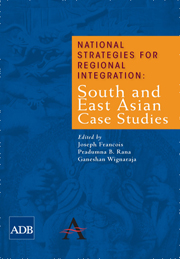5 - Nepal
from South Asian Perspectives
Published online by Cambridge University Press: 05 March 2012
Summary
Introduction
Nepal is a landlocked country of 23 million people with an area of 147,181 square kilometers (km). The country lies on the southern slopes of the Himalayas, bordering only two countries: the Tibet Autonomous Region of the People's Republic of China (PRC) to the north and India to the east, south, and west. The geographical situation facing Nepal presents a formidable challenge to domestic economic growth and development. Nepal has an open border with India, but for access to the world economy, the nearest seaport is that of Kolkata in India and is more than 900 km away from the country's border. Most of Nepal's terrain is mountainous or hilly, and only 20% of the total land area is arable. These factors contribute to country's high transport costs, hindering market development and creating a near-complete dependence on India for trading routes. The open border with India and the high cost of access to the markets of the rest of the world have been decisive factors in putting Nepal in this situation of de facto integration with India.
Nepal and the PRC have remained close friends and neighbors, with diplomatic relations being established in 1955. An agreement was signed between the two countries in 1961 to construct a 120-km highway linking Kathmandu to the border of the PRC's Tibet Autonomous Region and on to Lhasa.
- Type
- Chapter
- Information
- National Strategies for Regional IntegrationSouth and East Asian Case Studies, pp. 207 - 276Publisher: Anthem PressPrint publication year: 2009



